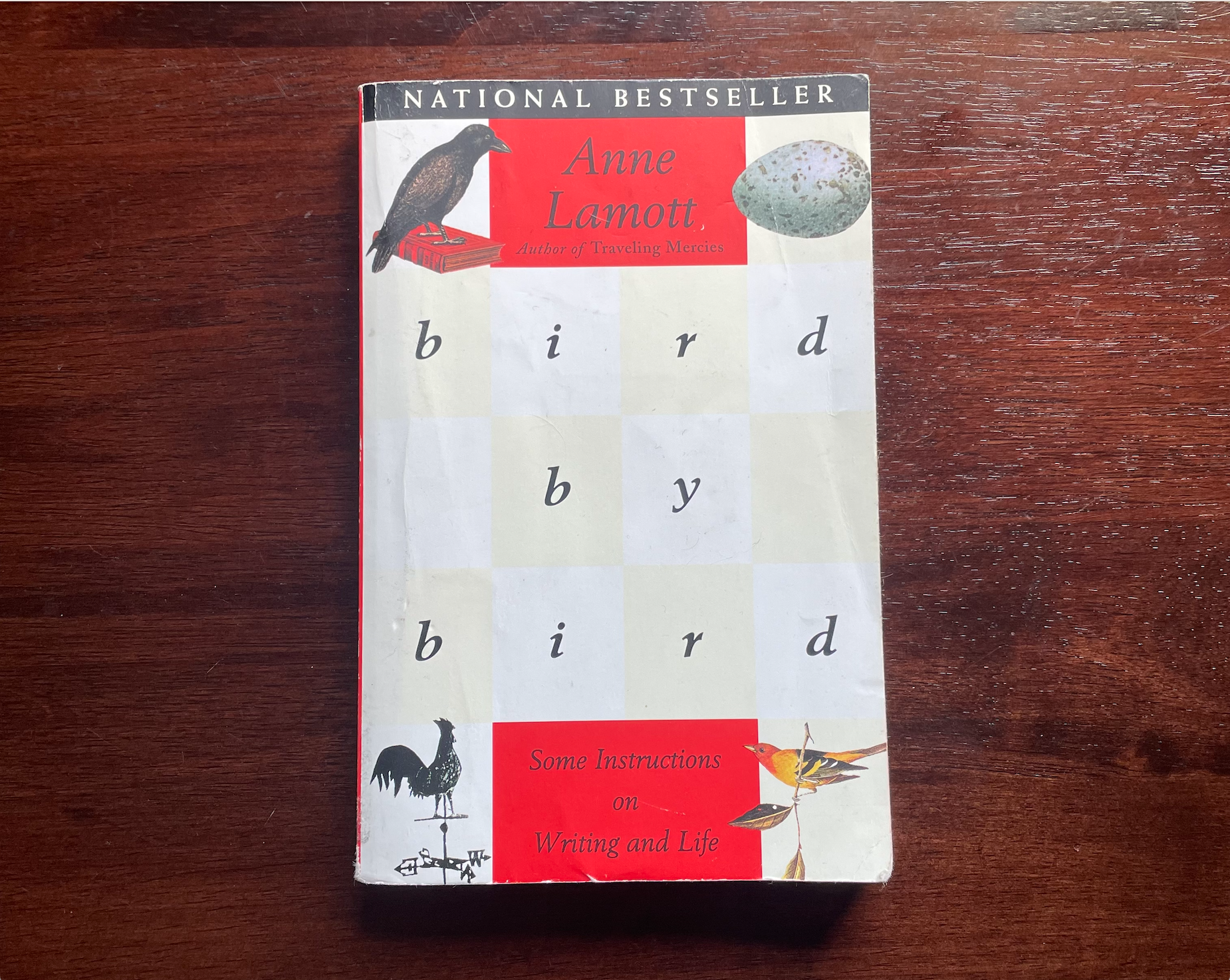Look no further for a summary and book review of the amazing Bird by Bird: Some Instructions on Writing and Life by Anne Lamott.
Look for a link to buy the book at the bottom of this post. After I share more on Lamott’s brilliantness in the summary of Bird by Bird, I am fairly confident you’ll want to pick up a copy.
Let’s jump into it
A Brief Summary of Bird by Bird
Similar to a lot of the books I find myself reading and reviewing, Bird by Bird touches on quite a few different genres. At its core, though, it’s a book about writing.
In chapter after chapter, Anne Lamott gives readers—who are all most likely writers themselves—tips and strategies for success in writing.
Two things to note here: to Lamott, success doesn’t necessarily mean publishing, although it did at one point in her life, which she shares in great detail. Success, rather, is about the process of writing and what one puts into it.
“Writing has so much to give, so much to teach, so many surprises. That thing you had to force yourself to do—the actual act of writing—turns out to be the best part. It’s like discovering that while you thought you needed the tea ceremony for caffeine, what you really needed was the tea ceremony. The act of writing turns out to be its own reward.”
— Bird by Bird (Lamott, 1994, p. xxvi)
The second note: Bird by Bird is FAR from one of those sterile books on writing techniques. One of the greatest things about this book is just how enjoyable it is to read.
While telling deeply personal stories about her own life in such a sarcastically comedic tone, Lamott shares with readers not only everything she has learned about writing during her long career but also how many of these same lessons can be applied to one’s life. It is this brilliant method of advice-giving that makes this book valuable for even those with no interest in writing.
Most Important Lesson from Bird by Bird
In one of the most simple yet profound parts of the book, Lamott shares a scene from her childhood with her dad and brother.
Her brother was struggling to write a homework report about birds. Though he had three months to write it, it was due the next day, and “he was at the kitchen table close to tears, surrounded by binder paper and pencils and unopened books on birds, immobilized by the hugeness of the task ahead” (Lamott, 1994, p. 19).
It was at this point when her father approached her 10-year-old brother and said, “Bird by bird, buddy. Just take it bird by bird”.
The advice left a great impact on Lamott, as she continues to share the story and wrote an entire book around it.
I, too, found this straightforward piece of advice to be incredibly helpful.
I can think back to countless pieces I’ve had to write for school that seemed as if they would never get written. But just taking it bird by bird, piece by little piece, is eventually what brought me to the finish line.
In my opinion, this was by far the most important lesson from the book.
The Beauty (and Ugliness) of Writing
I suppose this might be the case for other writers out there, but for Lamott, it’s obvious she has a love-hate relationship with writing.
Time and again throughout Bird by Bird, she refers to writing as something she questions almost daily. At the same time, she never seriously considering doing anything else.
She points to all the wonderful things that writing has to offer, like feelings of connection with yourself and others, in the same breath as describing it as a “desperate endeavor” (Lamott, 1994, p. 19).
This is exactly what makes her message so authentic, and one I want to emphasize in my summary of Bird by Bird.
Lamott’s not pretending like she has this thing all figured out, even though she’s a successful writer, at least in most people’s conceptualization of the word. Rather, she’s showing us how difficult and taxing this thing is while illustrating just how worth it writing can be.
I loved this.
It made me feel less bad about those days when I look at the computer and nothing seems to be coming out and I feel like pulling the very little hair I have and I want to give up.
Her thoughts on the dual nature of writing also made me appreciate that I am even capable of writing, whether for school, this blog, or leisure. This is a lesson from Bird by Bird that I don’t think I can ever forget.
Being Present in Writing and Life
Remember when I wrote that there are many of lessons in Bird by Bird that can be applied to life?
Being present is precisely what I mean by this.
“There is ecstasy in paying attention. You can get into a kind of Wordsworthian openness to the world, where you see in everything the essence of holiness, a sign that God is implicit in all of creation.”
— Bird by Bird (Lamott, 1994, p. 100)
We all know how important it is to be present in what we’re doing. We’ve been inundated with the movement of mindfulness and deluged with the idea that more presence equals more happiness.
Lamott’s approach to encouraging us to be present feels much more practical and less stuffing-it-down-your-throat-ish than other stuff I’ve read.
Her advice is more about getting out in the world, exploring, and being especially mindful of what you see. As she would have it, that is exactly what will help you get over whatever writer’s block you think you have.
“One of the gifts of being a writer is that it gives you an excuse to do things, to go places and explore. Another thing is that writing motivates you too. Look closely at life, at life as it lurches by and tramps around.”
— Bird by Bird (Lamott, 1994, p. xii)
The simplicity of noticing, of understanding that the next revelation—in writing and life—is likely right in front of us, so long as we calm our minds and pay attention, was incredibly resonant.
More lessons from Bird by Bird…
Let Go and Accept
A related piece of advice to being mindful, one that is way bigger than writing, is to let go and accept.
“I remind myself of this when I cannot get any work done: to live as if I am dying…To live as we are dying gives us a chance to experience some real presence. Time is so full for people who are dying in a conscious way, full in the way that life is for children. They spend big round hours. So instead of staring miserably at the computer screen trying to will my way into having a breakthrough, I say to myself, ‘Okay, hmmm, let’s see. Dying tomorrow. What should I do today?’”
— Bird by Bird (Lamott, 1994, p. 179)
Lamott shares that too many times writers try to force things. They (we?) attempt to force words on the page and stories that simply aren’t there. Or “sit staring at your blank page like a cadaver, feeling your mind congeal, feeling your talent run down your leg and into your sock” (Lamott, 1994, p. 176)
While she’s keen on getting at least 300 words down a day, regardless of whether those words will ever see the light of day, she encourages writers to let go of what they think they ought to be producing. In letting go, she wants writers to accept that there will be bad days and good days.
She says that “if you accept the reality you have been given—that you are not in a productive creative period—you free yourself to begin filling up again” (Lamott, 1994, p. 178).
What a relief to read this!
“It helps to resign as the controller of your fate. All that energy we expend to keep things running right is not what’s keeping things running right”
— Bird by Bird (Lamott, 1994, p. 180)
I’ve been struggling so much lately with my literature review. It seems I read and read, but have nothing to write. For almost two weeks I’ve sat in front of my computer hoping and praying something will come out, all to the tune of 3 (lousy) pages.
But this section in the book is helping me realize that it’s okay!
I’m not a machine.
I need to free myself from the expectations I’ve placed on myself.
This surely doesn’t mean to completely back off, but to let go and accept that I’m having a tough time. Things will eventually get better.
Has this happened to you at all lately?
No Bird by Bird summary or review is complete without mentioning how skilled Lamott is…
Lamott really is highly skilled.
She does a fantastic job at engaging readers through comedy, sarcasm, personal storytelling, and most of all, the fact that she cares.
It’s evident she cares about writing, both in the professional as well as the creative, leisurely sense. I think this is the main reason she’s so effective in delivering her message.
This is actually one of her pieces of advice towards the end of Bird by Bird. Essentially, she instructs us to find something we care deeply about and write about it. She adds that people will notice the genuine care and as a result, will want to engage with our work.
Talk about practicing what you preach…
Lamott is also highly motivational in her approach. And I get the sense that she’s not explicitly trying to be this way.
She certainly doesn’t want to not motivate us, but she’s not some motivational coach offering some weird gimmick. She’s honest and forthcoming about things she’s struggled with in her personal and professional life so that we can learn from her and use the lessons from her book to improve our writing and overall lives.
Seriously, Buy Bird by Bird
In general, I don’t actually recommend books when I write reviews.
Not because I think they’re unworthy of recommendation. Mostly every book I write a review for has impacted me in some way. But I just want you to make your own decision based on what you read in the summary and review.
Nevertheless, I do recommend buying this book. Especially if you’re someone who’s thinking about pursuing a career that involves a lot of writing.
There’s just so many lessons in Bird by Bird. I honestly didn’t scratch the surface in my Bird by Bird summary.
I only took one writing class in college, but it’d be hard to imagine professors not assigning this book.
It’ll teach you practical writing strategies, have you laughing out loud, and will prompt you to reflect on life.
I’d, personally, take a look at any book offering any of those three things, not to mention all three at once. If you decide to buy the book after reading my Bird by Bird summary and book review, let me know what you think of it in the comments.
Or, feel free to get in touch!
‘Till Next Time, Travel Friends!







